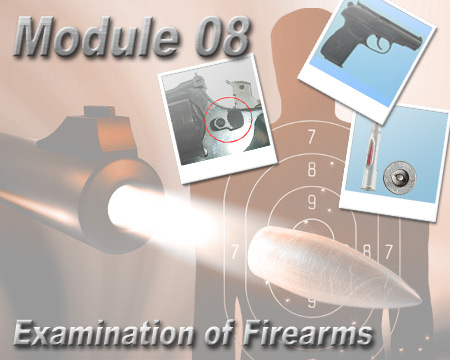Home | Glossary | Resources | Help | Contact Us | Course Map
Archival Notice
This is an archive page that is no longer being updated. It may contain outdated information and links may no longer function as originally intended.
| Author: William Conrad |
| William Conrad joined the U.S. Army in 1962 and became a criminal investigator in 1969. As a Criminal Investigation Command (CID) agent, he investigated felony offenses involving U.S. Army personnel and/or interests. Mr. Conrad was accepted into the firearms unit of U.S. Army CID crime laboratory where he completed a two-year resident course of instruction in firearm and toolmark identification and was certified by the Department of the Army as a firearm and toolmark examiner in January 1977. In this capacity, he worked on all aspects of firearm and toolmark examinations across all branches of the military. In addition, he was appointed as training officer for several students. In 1982, Mr. Conrad retired from the Army as a Chief Warrant Officer and began work with the Commonwealth of Virginia as a forensic scientist in firearm identification at the Western Regional Crime Laboratory. In 1994, he contracted with the Metropolitan Police Department, Washington, D.C., to design and implement a training program for firearm examiners. After training six examiners and four technicians, Mr. Conrad began work on the FBI's DRUGFIRE program as a subject matter expert. When the program ended, he went into private practice as a forensic consultant where he continues his work today. |
Introduction
This module discusses some of the most common types of firearms that an examiner might receive as evidence. The techniques presented can be adapted to any firearm. New models, variations of old models, and new designs are constantly introduced to the firearms marketplace, requiring the firearm examiner to continue to research and study new products.
Many people are exposed to the misuse of firearms through personal experience and misunderstandings. The firearm examiner must overcome misconceptions, and understand and be able to explain the type of firearm, its capabilities and limitations, and how this information correlates with the facts of the case.
The firearm examiner must be able to do the following:
- Classify firearms
- Determine operability
- Explain the safety features of the firearm and their proper function
In addition, having an understanding of how a particular firearm functions allows the examiner to determine what type of identifiable microscopic marks may be present on submitted bullets and cartridge cases.
The quality assurance officer or appointed individual will do an administrative and technical review of the results of the examination and attest that the protocols have been adhered to throughout.
Objectives
At the conclusion of this module the student should be able to do the following:
- Explain the cycle of fire for manufactured firearms
- Describe the evidence documentation required prior to the examination
- Identify the type, caliber, action, and safety features of firearms through visual examination
- Know how to conduct a safety and functionality examination of a firearm before conducting test fires
- Describe how a firearm functions, including its capabilities and limitations
- Describe safety features of firearms and how they function or are determined to be nonfunctional
- Describe the methods of test firing a firearm including full automatic, single-action, and double-action type firearms
- Describe how to perform a drop test
AFTE Knowledge and Ability Factors
| 14. | Knowledge of how to properly document evidence and analytical results (through notes, sketches, photography, reports, etc.) |
| 15. | Knowledge of the techniques and procedures used to properly mark evidence (when appropriate) |
| 38. | Knowledge of how and when to use various vises, clamps, and restraining devices |
| 39. | Knowledge of how and when to use gunsmithing tools |
| 43. | Knowledge of how and when to use borescopes |
| 44. | Knowledge of how and when to use bore lights |
| 70. | Knowledge of how and when to use spring trigger pull scales |
| 71. | Knowledge of how and when to use trigger pull weights |
| 76. | Knowledge of breech-loading firearms designs, including falling breechlocks, bolt actions, lever actions, pump actions, break open, semiautomatics (blowback, gas operated, recoil operated, etc.), revolvers--double and single action |
| 77. | Knowledge of firearms ignition systems: flintlock, percussion, rimfire, centerfire, caseless ammunition |
| 80. | Knowledge of sources of information regarding identification markings and serial numbering systems in firearms (including locations of serial numbers, part/assembly numbers, proof marks on firearms and the locations of hidden numbers) |
| 81. | Knowledge of the proper operation of the different types of firearms encountered in casework |
| 82. | Knowledge of the different materials that may be present in the bore of a firearm |
| 19. | Ability to understand and interpret technical data output from laboratory instruments |
| 21. | Ability to recognize discrepancies or inconsistencies in analytical findings and determine their cause and significance |
| 22. | Ability to recognize utility and limitations of reference collection/database programs |
| 23. | Ability to recognize the limitations of tests and interpretations |
| 24. | Ability to determine the design of the lockwork (firing system) in firearms |
| 25. | Ability to locate and identify the type (or types) of safety system(s) incorporated in a particular firearm |
| 26. | Ability to determine the design type, method of operation, and ignition of a submitted firearm |
| 27. | Ability to recognize when a firearm has been altered from its original design |
| 32. | Ability to examine, either directly or through the use of casts, the interior surface of a gun barrel to determine the method of rifling |
| 35. | Ability to evaluate the operability of each safety system, chambering method, and lockwork, recognize and explain any defects or failures in each of these systems and the consequences of any such defect or failure |
| 36. | Ability to compare firearm mechanisms with standards |
| 37. | Ability to recognize which parts of a firearm leave tool marks of forensic interest |
Additional Online Courses
- What Every First Responding Officer Should Know About DNA Evidence
- Collecting DNA Evidence at Property Crime Scenes
- DNA – A Prosecutor’s Practice Notebook
- Crime Scene and DNA Basics
- Laboratory Safety Programs
- DNA Amplification
- Population Genetics and Statistics
- Non-STR DNA Markers: SNPs, Y-STRs, LCN and mtDNA
- Firearms Examiner Training
- Forensic DNA Education for Law Enforcement Decisionmakers
- What Every Investigator and Evidence Technician Should Know About DNA Evidence
- Principles of Forensic DNA for Officers of the Court
- Law 101: Legal Guide for the Forensic Expert
- Laboratory Orientation and Testing of Body Fluids and Tissues
- DNA Extraction and Quantitation
- STR Data Analysis and Interpretation
- Communication Skills, Report Writing, and Courtroom Testimony
- Español for Law Enforcement
- Amplified DNA Product Separation for Forensic Analysts



